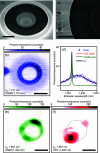Optical coupling of individual air-suspended carbon nanotubes to silicon microcavities
- PMID: 38866479
- PMCID: PMC11377212
- DOI: 10.2183/pjab.100.022
Optical coupling of individual air-suspended carbon nanotubes to silicon microcavities
Abstract
Carbon nanotubes are a telecom band emitter compatible with silicon photonics, and when coupled to microcavities, they present opportunities for exploiting quantum electrodynamical effects. Microdisk resonators demonstrate the feasibility of integration into the silicon platform. Efficient coupling is achieved using photonic crystal air-mode nanobeam cavities. The molecular screening effect on nanotube emission allows for spectral tuning of the coupling. The Purcell effect of the coupled cavity-exciton system reveals near-unity radiative quantum efficiencies of the excitons in carbon nanotubes.
Keywords: Purcell effect; carbon nanotubes; cavity quantum electrodynamics; microcavity; silicon photonics.
Figures







Similar articles
-
Ultralow mode-volume photonic crystal nanobeam cavities for high-efficiency coupling to individual carbon nanotube emitters.Nat Commun. 2014 Nov 25;5:5580. doi: 10.1038/ncomms6580. Nat Commun. 2014. PMID: 25420679 Free PMC article.
-
Exploiting One-Dimensional Exciton-Phonon Coupling for Tunable and Efficient Single-Photon Generation with a Carbon Nanotube.Nano Lett. 2017 Jul 12;17(7):4184-4188. doi: 10.1021/acs.nanolett.7b00973. Epub 2017 Jun 29. Nano Lett. 2017. PMID: 28641011
-
Tuning the coupling between quantum dot and microdisk with photonic crystal nanobeam cavity.Opt Express. 2019 Jul 22;27(15):20211-20220. doi: 10.1364/OE.27.020211. Opt Express. 2019. PMID: 31510119
-
Enhanced Single-Photon Emission from Carbon-Nanotube Dopant States Coupled to Silicon Microcavities.Nano Lett. 2018 Jun 13;18(6):3873-3878. doi: 10.1021/acs.nanolett.8b01170. Epub 2018 May 24. Nano Lett. 2018. PMID: 29781621
-
Optical microcavity: sensing down to single molecules and atoms.Sensors (Basel). 2011;11(2):1972-91. doi: 10.3390/s110201972. Epub 2011 Feb 7. Sensors (Basel). 2011. PMID: 22319393 Free PMC article. Review.
References
-
- Thomson D., Zilkie A., Bowers J. E., Komljenovic T., Reed G. T., Vivien L., et al. (2016) Roadmap on silicon photonics. J. Opt. 18, 073003.
-
- Wang Z., Abbasi A., Dave U., De Groote A., Kumari S., Kunert B., et al. (2017) Novel light source integration approaches for silicon photonics. Laser Photon. Rev. 11, 1700063.
-
- Kong J., Soh H. T., Cassell A. M., Quate C. F., Dai H. (1998) Synthesis of individual single-walled carbon nanotubes on patterned silicon wafers. Nature 395, 878-881.
-
- O'Connell M. J., Bachilo S. M., Huffman C. B., Moore V. C., Strano M. S., Haroz E. H., et al. (2002) Band gap fluorescence from individual single-walled carbon nanotubes. Science 297, 593-596. - PubMed
-
- Weisman R. B., Bachilo S. M. (2003) Dependence of optical transition energies on structure for single-walled carbon nanotubes in aqueous suspension: An empirical Kataura plot. Nano Lett. 3, 1235-1238.

